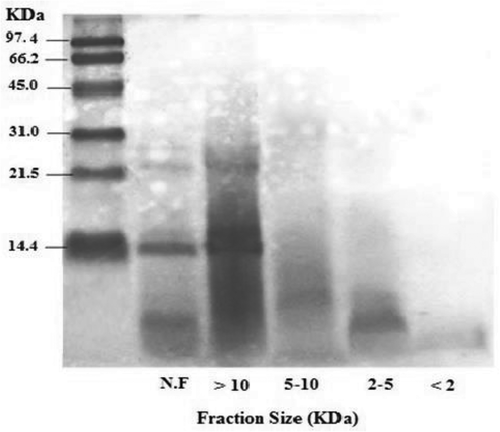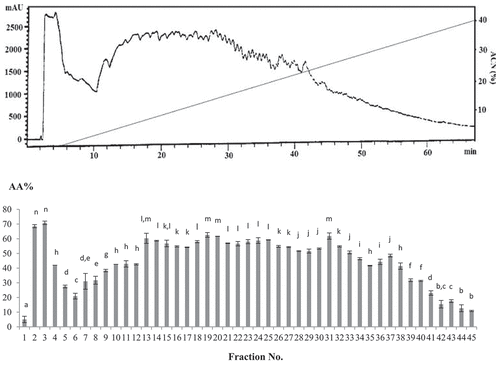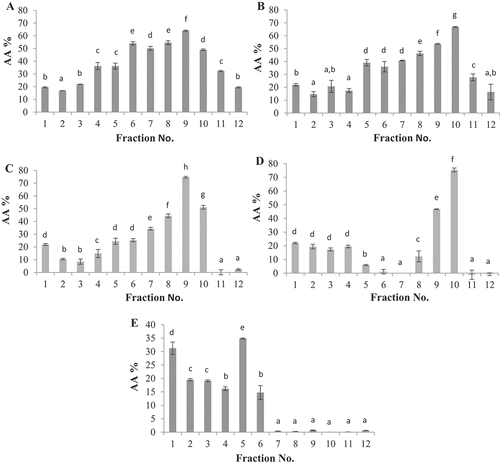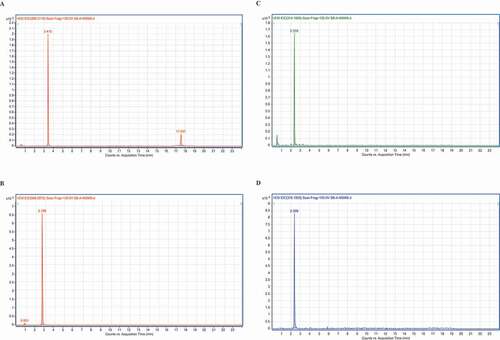Figures & data
Table 1. Peptide content, degree of proteolysis (DP) and antioxidant activity of alcalase digested proteolysates of stone fish flesh during 8 h of proteolysis.
Figure 1. Correlation between antioxidant activities ((a) DPPH•, (b) ABTS• radical scavenging activity and (c) FRAP reducing power) and degree of proteolysis of stone fish proteolysates during 8 h of digestion with alcalase.

Table 2. Physicochemical properties of stone fish proteolysates in comparison to other marine-based proteolysates.
Table 3. The yield and DPPH• radical scavenging activity of stone fish proteolysate ultrafiltration fractions.
Figure 2. SDS-PAGE patterns of unfractionated stone fish selected proteolysate and its ultrafiltrated fractions. MW: molecular weight, N.F: unfractionated stone fish proteolysate. >10: fraction with MW > 10 KDa, 5–10: fraction with MW between 5 and 10 KDa, 2–5: fraction with MW between 2 and 5 KDa <2: fraction with MW < 2 KDa.

Figure 3. RP-HPLC fractions chromatogram vs. DPPH• radical scavenging assay. The subscriptions a-n indicated the significant differences at P ≤ 0.05, (mean ± SD, n = 3).

Figure 4. DPPH• radical scavenging activity of OFFGEL fractions obtained from alcalase proteolysate. The subscriptions a-h indicated the significant differences at P ≤ 0.05, (mean ± SD, n = 3). A: al-2, B: al-3, C: al-19, D: al-20 and E: al-31. F.N: Fraction Number, AA%: antioxidant activity %.

Figure 6. MS/MS chromatogram, a: peptide 1 (GVSGLHID), score: 76.1, ion intensity: 4.19E+ 05, RT (min): 3.42, precursor m/z: 399.2115, matched m/z: 797.416. b: peptide 2 (PTPSRPQQGPA), score: 58.6, ion intensity: 1.75E+ 06, RT (min): 2.8, precursor m/z: 568.2972, matched m/z: 1135.586. c: peptide 3 (PGRRAA), score: 64.2, ion intensity: 2.59E+ 05, RT (min): 2.35, precursor m/z: 314.1826, matched m/z: 627.369. d: peptide 4 (LAQVAVSNPNN), score: 56.4, ion intensity: 2.03E+ 05, RT (mins): 2.37, precursor m/z: 376.1959, matched m/z: 1126.586.

Table 4. Stone fish-derived peptides characteristics and antioxidant activities.

